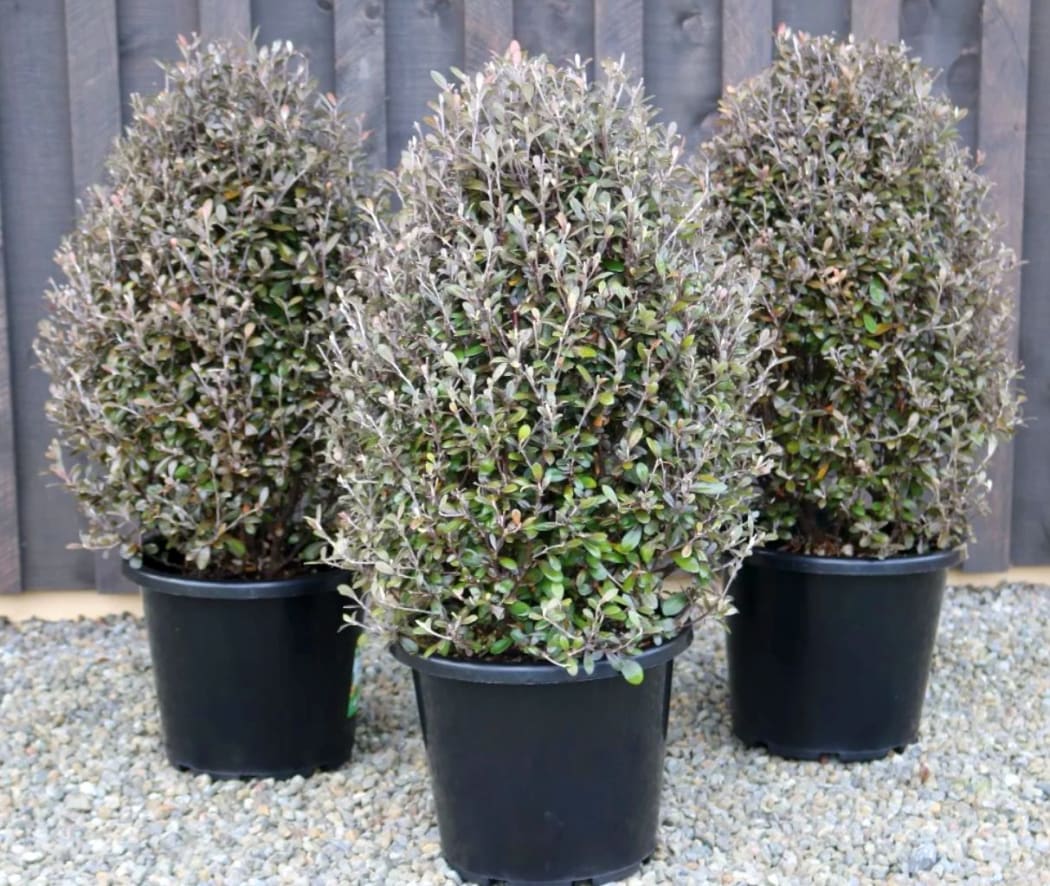Landscape gardener Xanthe White says the compact nature of topiaries can be put to good use to create space in even a small garden for natives.

Corokia x virgata 'Frosted Chocolate' topiary pots Photo: Hedge Garden Design & Nursery
Topiary is the act of shaping and forming plants, clipping them into shape, she told Nine to Noon.
“Some people see it as plant torture, but I see it as really creating an opportunity to integrate more diversity into our living spaces.
“Using natives for topiary as a way of using our culture of gardening to actually bring more diversity into our spaces rather than seeing gardening is over here, and the wild is over there.”
Start with design
Consider the space or shape that you're trying to define, and then what plant is going to make that shape happen, she says.
“So, for instance, if you want a larger shape, then starting with something like a hebe, that will get to about 1.5 meters.
“If you want something to be 2 meters, better to go for something like a totara which is going to grow larger.”
The advantage of natives in topiary is that they have a wide range of different foliage colours, she says.
“You can get beautiful silvers in the corokias and reds in the coprosmas and things like muehlenbeckia are really suited for beautiful cloud forms, pseudowintera, has beautiful yellows and reds and quite variegated colours to it if you want something a little bit more, sort of explosiveness.
“So, there's quite a lot of diversity in terms of colour that they can bring into a garden as well.”
When to plant, when do you prune?
“Well, you can really plant at any time with evergreen plants. But one of the things to avoid, is pruning when you've got a lot of soft spring growth. So, now's a good time to get started with your topiary,” White says.
Faster growing varieties, will probably need a shape again in the late summer, she says.
Start in a pot
“Setting out in a pot will help you get the form of the plant a lot more easily, because you can turn a pot around and look at it, then if you're not practiced at clipping things, being able to turn something, look at it and move around, it will help you practise.
“And it also means that you can get the shape right before you put it out into the garden”, she says.
What sort of tools are you going to need?
Keep them sharp and clean, she says.
“For topiary, you want a nice flat blade, because it gives you more precision. If you have a curved blade, you're more likely to take a chink out of a plant.
“So, things like secateurs that often have a curve on them are not so good for topiary.”
Hygiene is also important, she says.
“So, when you're doing topiary, it's good idea just to have a little bit of soapy water in a bucket and just to wipe those tools clean in between each plant as you go so that you're not at risk of spreading infection through the garden.
“Just like surgery, your tools should be clean, you're opening something up, make sure that you've got a good hygienic situation.”
Free form or formal?
“There's two ways of doing topiary, there's the freestyle way, which is where Uncle Jim decides that you need an elephant out front and kind of gets creative and the topiary gets trained into magical dinosaurs and things like this.
“And this is a legitimate art form, which brings a lot of joy to the people walking down the road.”
A more formal approach to topiary requires a framework, she says.
“This can be done quite easily. bamboo sticks are a really wonderful way to set out a frame and just tying them at corners like with a little bit of garden wire to create either a square or a pyramid shape, which then just gives you a guide for your eye to make sure that you're getting that geometry
“At places like Versaille they have plyboard templates, which they cut out to make sure that their shapes maintain precision.
“And they move these around the side of the plants to make sure that the topiary is absolutely perfect.
“So, if you want to say perfect, you need to make sure that you are measuring and you're being precise.”
Natives that like confined spaces
There are lots of plants that actually love being in that confined root space; things like the poor knight’s lilies, they’re a nema callistemon and grow really beautifully, it prefers the littlest pot that you can possibly cram it into.
“And it will flower splendidly in that situation. This is because that's sort of natural environment. It grows and very tight, gravelly soils.”
Epiphytes which grow in the tree canopy are very used to grow with small root systems and thrive in pots, she says.
“But there's also little creepers and that will trail down the sides of your pot. Fuschia procumbens is a really beautiful, soft, lush green, ground cover that will come down and has beautiful little berries and quite delicate little flowers.
"Pimelea prostrata is a great one, it's actually got a soft scent to it, some people call it a New Zealand daphne it has a soft silvery foliage so doesn't need a lot of water, which is great for our pots.
"And things like our grasses chinochloa flavicans, which is kind of like a mini toetoe that grows beautifully in a pot has beautiful flower heads.
“And one of my favorite plants is the pseudopanax furox which grows up like a lance wood and then turns almost into a perfect pompom topiary once it's about 20 years old. But it has a really naturally confined form. So, it thrives in those sorts of environments.”

